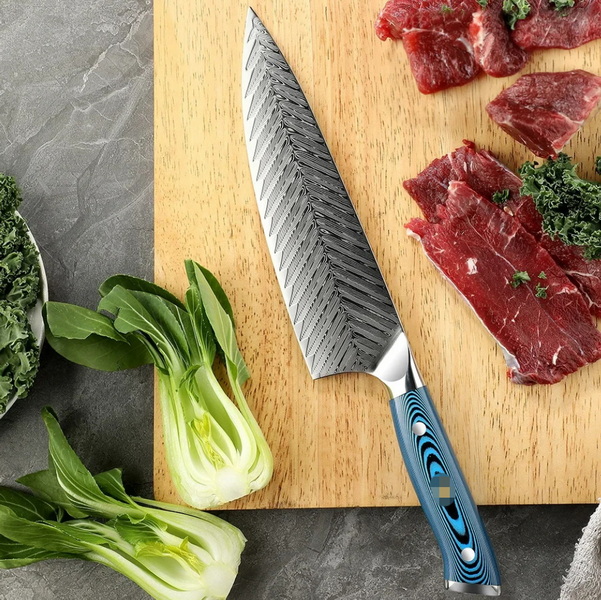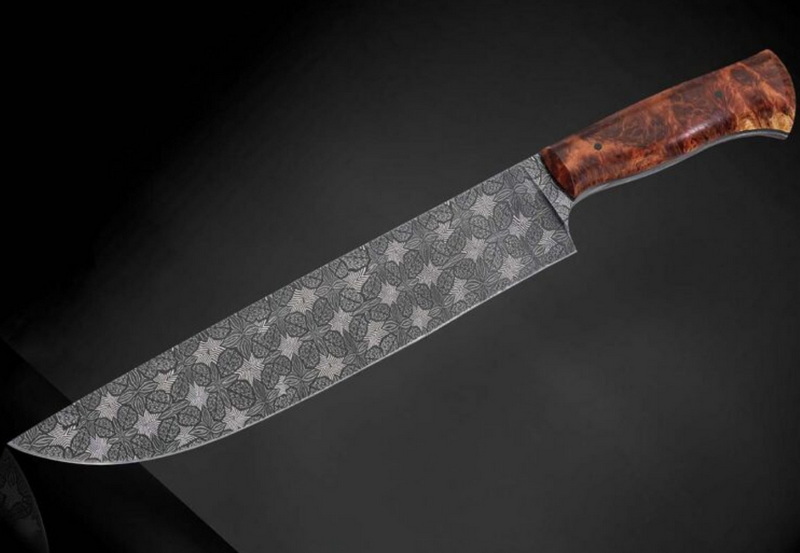- All
- Product Name
- Product Keyword
- Product Model
- Product Summary
- Product Description
- Multi Field Search
Views: 222 Author: Ann Publish Time: 2025-10-18 Origin: Site











Content Menu
● Understanding Damascus Knife Patterns
>> Formation and Types of Patterns
● The Impact of Patterns on Performance
>> Edge Retention and Sharpness
● The Art and Science of Damascus Knife Manufacturing
>> Selecting and Stacking Steel Layers
● The Aesthetic Power of Damascus Knives
>> Optical Effects and Uniqueness
● Practical Benefits in the Kitchen
● Care and Maintenance Tips for Damascus Knives
>> 1. Do Damascus patterns affect knife cutting performance?
>> 2. Are all Damascus knives the same?
>> 3. How do Damascus knives resist corrosion?
>> 4. Can Damascus knives be sharpened like other kitchen knives?
>> 5. Are Damascus knives suitable for professional use?
Damascus knives have long captivated enthusiasts and professionals alike, not only for their striking visual patterns but also for their exceptional performance in culinary tasks. This article explores how the unique patterns found in Damascus knives influence both their functional qualities and their aesthetic appeal.

At the heart of Damascus knives lies a complex layering technique, where different types of steel, typically high-carbon and low-carbon varieties, are forge-welded together. This process creates distinctive swirling, zigzag, or waved patterns visible on the blade surface after acid etching. Each blade is essentially a unique fingerprint, making every Damascus knife one-of-a-kind.
Patterns such as ladder, raindrop, twist, feathered, and watered are common motifs arising from manipulating the steel billets during forging. These patterns are not merely decorative; they reflect the internal structure of the blade, impacting its performance characteristics.
Visualizing the pattern formation can be likened to folding and twisting layers of steel, which after etching, reveal the contrasts between hard and soft layers.
The layering technique produces micro-serrations along the blade edge, enhancing cutting efficiency. The incorporation of hard carbide particles within the steel layers helps maintain sharpness over extended periods, reducing the frequency of sharpening required.
Alternating soft and hard steel layers provide a balance that prevents brittleness. The softer layers absorb shocks and stresses, reducing the risk of chipping or cracking when the knife is used for rigorous kitchen tasks.
While traditional Damascus steel can be prone to rust due to carbon content, modern Damascus knives often integrate stainless steel layers or protective coatings to enhance corrosion resistance without sacrificing the blade's distinctive patterned appearance.
The forging process allows blacksmiths to create blades that are strong yet lightweight, improving balance and ergonomics. This makes Damascus knives comfortable to use during prolonged cutting, slicing, or chopping sessions.
The process of making a Damascus knife is a meticulous blend of craftsmanship and metallurgy that influences both its visual appeal and performance.
The process begins by selecting high-quality steels with varying carbon content, such as 1095 high-carbon steel for hardness and 15N20 nickel steel for flexibility and corrosion resistance. These steels are cut into identically sized plates and carefully stacked in alternating layers to form a billet. Precision in stacking ensures consistent layering, which is critical for both the blade's strength and pattern clarity.
The stacked billet is heated in a forge to a bright red temperature and then hammered or pressed to fuse layers together in a process called forge welding. This is repeated multiple times, folding the steel to increase the layer count—sometimes reaching thousands of layers. The repeated folding refines the blade's structure and enhances its toughness.
After sufficient layering, the billet is shaped into a blade form. The blade undergoes annealing and normalizing to relieve internal stresses, followed by hardening and tempering at carefully controlled temperatures. This step optimizes the blade's hardness without making it too brittle.
The final step in Damascus knife production involves polishing and acid etching. Acid dissolves the different steel layers at varied rates, bringing forward the contrasting patterns that define the Damascus aesthetic. Careful monitoring during etching is essential to prevent over-etching, which could erode detailed patterns.
Polishing finishes the blade, enhancing both its appearance and protection. Handles are then attached, often made from high-quality wood, composites, or micarta, completing the knife.

The distinctive patterns on Damascus knives contribute a timeless beauty that merges art with function. The contrast between light and dark layers crafted through acid etching highlights the craftsmanship and symbolizes the blade's durable engineering beneath its surface. This visual appeal is a key reason Damascus knives are prized collectibles and considered heirloom-quality tools.
The microscopic layering and surface topography cause light to refract uniquely, creating striking visual effects such as an iridescent shimmer. Because every forge weld, fold, and twist is unique, no two blades present the exact same pattern. This exclusivity greatly enhances the allure for chefs, collectors, and knife enthusiasts.
Chef and home cooks appreciate Damascus knives not just for their looks but also for their exceptional utility. Their sharpness facilitates delicate precision tasks like mincing herbs or filleting fish, while the strong yet flexible blade resists chipping and can handle heavier chopping tasks.
Beyond functionality, owning a Damascus knife connects users with centuries of tradition and craftsmanship, elevating the cooking experience with a tool that is both beautiful and highly effective.
To preserve both the performance and beauty of a Damascus knife:
- Clean knives by hand immediately after use and dry thoroughly to prevent rust.
- Avoid harsh detergents or abrasive scrubbers that can damage the pattern and finish.
- Regularly oil the blade lightly with food-safe mineral oil, especially after cleaning.
- Sharpen with whetstones or professional sharpening systems to maintain the edge without compromising the blade structure.
- Store knives in a dry place, ideally in a wooden knife block or sheath to protect the blade.
Damascus knives represent a magnificent fusion of artistic expression and technical innovation. Their iconic patterns are not just ornamental but reflect complex forging techniques that improve the blade's flexibility, edge retention, and toughness. The process from selecting steel layers to finishing with acid etching defines both the blade's performance and visual uniqueness. For chefs and collectors alike, Damascus knives offer a perfect blend of heritage, craftsmanship, and practical excellence, making them a valued addition to any kitchen.

Yes, the layered structure that forms the patterns also creates micro-serrations and combines hard and soft steel, improving both sharpness and durability.
No, each Damascus knife has a unique pattern due to variations in the forging, folding, and etching process, making every blade one-of-a-kind.
Traditional Damascus blades may rust, but modern versions often use stainless steel layers or protective finishes to enhance corrosion resistance.
Absolutely, Damascus knives can be sharpened using whetstones or sharpening systems, but they benefit from careful handling to preserve the pattern.
Yes, their combination of sharpness, toughness, and balance makes Damascus knives ideal for professional chefs and serious home cooks alike.
The Ultimate Professional Knives for Halal Butchery in Middle Eastern Kitchens
Chef Knife Size Guide: Choosing Between 6″, 8″, 10″, And 12″
Custom Knife Handles: How To Design A Chef Knife That Fits Your Hand Perfectly
Chef Knife Surface Treatments Guide: From Polished Migaki To Damascus Patterns
Inside Our Professional Knife Sample Room: Quality You Can See
Universal Knife Block Buying Guide: Modern Acrylic & ABS Knife Holders for Professional Kitchens
Universal Knife Block: The Complete Guide To Modern, Hygienic Knife Storage
The Complete Guide To Red Handle Knife Sets: Style Meets Functionality in The Kitchen
Professional Knives for Halal Butchery And Middle Eastern Cuisine